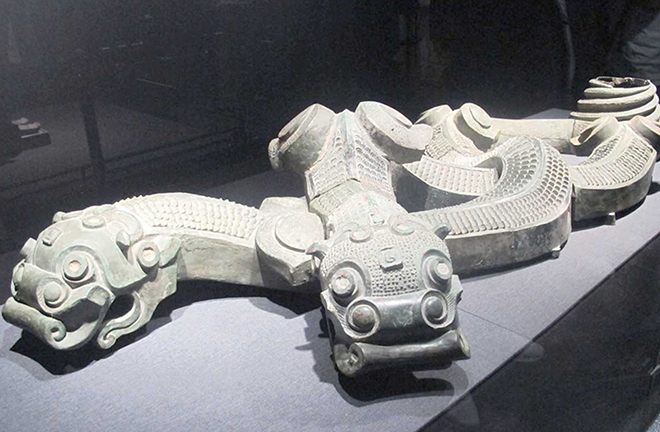Lost Qin dragons: a tale of smuggling and discovery

FILE PHOTO: The pair of intricately intertwined bronze dragons housed in the Shaanxi History Museum
In the winter of 1993, the Shaanxi police launched a provincial operation to combat motor vehicle theft. One day, while checking vehicles at a checkpoint in Xi’an, officers noticed a suspicious car. A search revealed several ancient bronze artifacts hidden inside the trunk. During later interrogation, the driver explained that an acquaintance named Xu had enlisted him to transport the items to Guangzhou. The police then followed this lead, arresting Xu, two others named Cai and Qian, along with others involved in the scheme. However, the police were unable to determine the location where the bronze artifacts were unearthed, whether other items were found along with them, or any information about the tomb owner.
A careful inventory of the recovered items identified eight bronze fragments, weighing a total of 92.5 kilograms. According to the suspect’s confession, the artifacts were too large to be smuggled intact, so they had been carefully cut into eight sections for easier transportation. The fragments were subsequently transferred to the Shaanxi History Museum, where experts in cultural relic restoration began their painstaking work. Their efforts revealed the fragments to be part of a pair of intricately intertwined bronze dragons, their true significance now slowly coming to light.
After restoration, the bronze dragons measured an impressive 240 cm in length, 100 cm in width, and 40 cm in height. Their hollow bodies were adorned with slightly square heads, bulging eyes, upturned noses, and open mouths. They were further decorated with intricate fish-scale patterns, while their tails were coiled into conical shape, into which a column-like object could be inserted. The scale motifs on the dragons’ bodies and the round dot patterns on their feet were characteristic of the Spring and Autumn (770–476 BCE) and Warring States (475–221 BCE) periods. Based on these features, experts identified the bronze dragons as originating from the Qin State (770–207 BCE) or the Qin Dynasty (221–207 BCE) during the Warring States period. Both dragons were originally cast with four legs and feet, but sadly, none remain fully intact. The bodies of the dragons were cast in segments and welded together, and their immense size, regal design, and exquisite craftsmanship make them the largest bronze dragon-shaped artifacts ever discovered in China. Today, they are housed in the Shaanxi History Museum.
During ancient Chinese dynastic periods, the dragon was generally a symbol of imperial authority. Such a large and exquisite bronze artifact could not have come from a common tomb nor belonged to ordinary people. Instead, it was likely used as a base for a grand palace musical instrument. The Records of the Grand Historian (Shiji) recount that in 221 BCE, Qin Shi Huang ordered the melting down of weapons from across the empire to be repurposed into “zhong ju,” frames used to hang a set of bells or chimes. The features of the bronze dragons—particularly the hole at the tail—align with descriptions of the “zhong ju” in historical texts, suggesting the hole was intended to accommodate the post that would support bells and chimes. Some experts also speculate that the bronze dragon-shaped object served as a ritual vessel, perhaps part of a set of four or more, with the intertwined dragons positioned to support each other on either side. Qin culture was renowned for its grandeur and majesty, with the Warring States period and the era following China’s unification representing the pinnacle of this tradition.
Yang Shuming is a distinguished research fellow from Shaanxi Academy of Social Sciences.
Edited by REN GUANHONG
